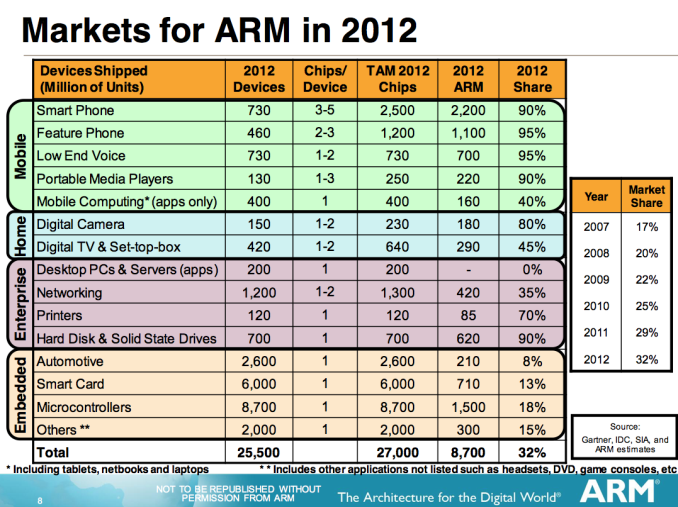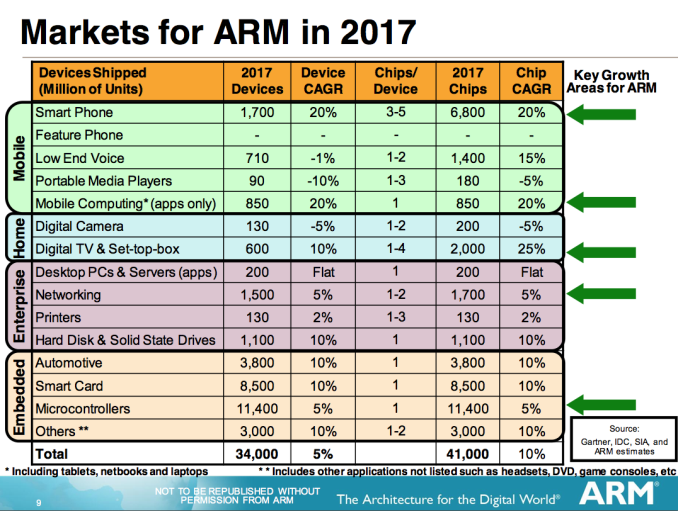The ARM Diaries, Part 1: How ARM’s Business Model Works
by Anand Lal Shimpi on June 28, 2013 12:06 AM ESTMarket Share
In 2012, ARM licensees shipped around 8.7 billion chips. Depending on the market segment, a single device can have anywhere from one to many ARM cores in it. Even looking within a smartphone you have multiple ARM cores not only within the apps processor but also inside the modem.
Although ARM has tremendous market share within the ultra mobile space (90%+), more than half of its shipments come from other segments. Enterprise, digital home, TVs, etc... are all expected to be drivers of growth for ARM in the coming years. By 2017 ARM expects its customers to be shipping roughly 41 billion chips that use ARM IP every year.
Final Words
Business models that leverage the scale and strength of a distributed production model are often very disruptive. ARM designs IP that can be implemented by fabless and fully integrated semiconductor companies very quickly, and at relatively low cost. No one member of the supply chain has to assume a significant amount of risk relative to others in the chain. It’s a far more democratic and partner centric approach to chip supply, which is one reason that it’s done so well.
ARM’s business allows for the creation and sustainability of several chip companies, which in turn keeps prices very low and prevents consolidation of power in any one firm. Although other factors (e.g. modem business, patent licensing) have lead to dominance in specific markets, ARM’s overall impact on the industry is one of promoting competition and keeping (silicon) prices low. ARM quite obviously enables what Qualcomm calls the Internet of things, where nearly everything is connected and computes.
It’s important to note that although our focus on ARM tends to be in the smartphone and tablet space, the majority of its licensed shipments come from other areas. It’s quite likely that ARM’s chances for future growth in terms of margin are in higher-end mobile SoCs, but competition from Intel in one segment surely won’t be the end of the world for ARM.
In the coming parts I’ll be taking a look at some of ARM’s newly announced microprocessor architectures such as the Cortex A12, A53 and A57. I’ll also be looking a little deeper into big.LITTLE and Mali graphics.












64 Comments
View All Comments
3dcgi - Sunday, June 30, 2013 - link
Anand, do you have info on how the cost of an architecture license differs from a regular IP license? I assume it's a higher upfront license cost and lower royalty cost, but haven't seen this specified anywhere. Thanks.hazydave - Tuesday, July 2, 2013 - link
I actually wonder how much of Intel's fortune is really within their control anymore. On the one hand, it's hard to imagine why Intel, the only company really making a consumer-oriented CPU selling retail at about $1,000 every year, working so hard to match price, power, and performance against a market based on SOC's that OEM at $15.On the other hand, Intel's superpower has always been cash, and cash has always depended on volume. Intel clearly sees the Windows marketing contracting, and feels they need to make the jump to whatever's next. Android can of course run on Intel, it's actually been a standard thing for the last few versions. And that could be key... it's expected about 850 million Android devices ship this year, versus about 350 million Windows devices. Not as much cash, clearly, but it does suggest that this doesn't have to happen for too many years in a row to see Android going to replace most of the desktop uses, and desktops becoming niche.
Intel did a pretty good job destroying every niche processor within range of the x86. SPARC and Power still hang on at the high end, AMD used their x86-64 to kill off Intel's IA-64 (ok, sure, Intel helped a lot there too). MIPS and PowerPC are mitigated to embedded... only ARM is a primary application processor against Intel (and occasionally AMD) these days.
But Intel's definitely risking getting dragged down with Microsoft. Maybe Microsoft will bounce back on better x86s, maybe not. Intel doesn't seem willing to take that risk, and you can't exactly blame them.
goo.gle - Saturday, July 20, 2013 - link
Give us the next one already! :DEN10 - Thursday, August 8, 2013 - link
Looks like Charlie Demerjian is taking your images & article notes and putting his stamp on them. Bit naughty, or just a coincidence?http://semiaccurate.com/2013/08/07/a-long-look-at-...
http://semiaccurate.com/2013/08/08/how-arm-license...